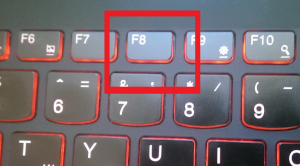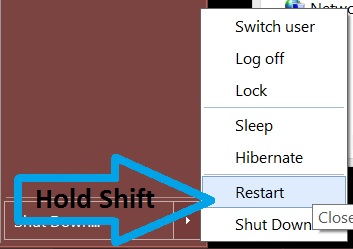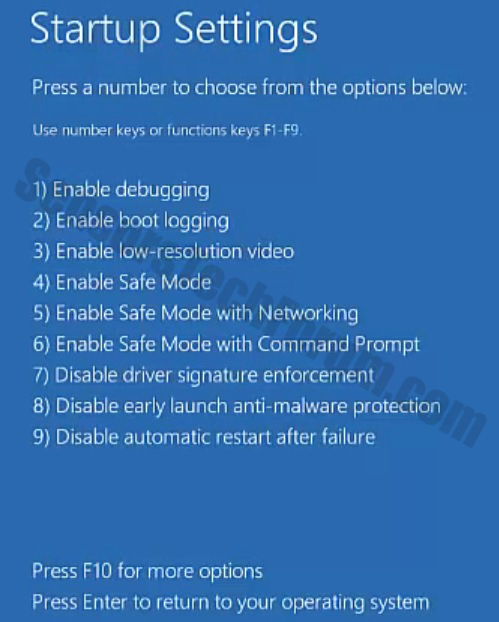TrojanDownloader:Win32/Bagoox.A is a malicious threat that may drop other pieces of malware onto the system. Trojan downloaders such as Bagoox are usually designed to download and install potentially unwanted programs (PUPs).
| Name | TrojanDownloader:Win32/Bagoox.A |
| Type | Trojan Horse, Trojan Downloader |
| Short Description | The Trojan can drop other malware onto the system. |
| Symptoms | Not known yet. |
| Distribution Method | Unsafe browsing, installation of pirared software, p2p file sharing, etc. |
| Detection Tool | Download Malware Removal Tool, to See If Your System Has Been Affected by malware |
| User Experience | Join our forum to start a discussion about TrojanDownloader:Win32/Bagoox.A. |
Note that they may be also employed to spread spyware (like other types of Trojan horses that target sensitive information) and rogue software. TrojanDownloader:Win32/Bagoox.A may not be the most sophisticated Trojan horse detected in the wild but its capabilities are not to be overlooked. Bagoox is crafted to alter the system and change certain settings in a stealth manner.
TrojanDownloader:Win32/Bagoox.A Installation Method
(red) Trojan horses can sneak into the system via backdoor access, spam email messages, zero-day vulnerabilities, torrents and p2p file sharing, pirated software. The exact distribution method of TrojanDownloader:Win32/Bagoox.A is not specified yet. 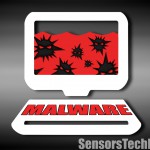
NOTE
However, this particular Trojan may have been created to spread TrojanClicker:Win32/Bagoox.A and other Bagoox-related malware. TrojanClicker:Win32/Bagoox.A can be quite harming to the system. Trojan Clickers can use the victim’s PC to click on ads without his permission or knowledge. Clickers are typically used to generate online income for hackers.
Technical Details
Once installed, the Trojan can create files such as:
- %TEMP%\clients\
.exe
Then, the attack will continue and other malware can be downloaded onto the PC. What is worse, TrojanDownloader:Win32/Bagoox.A can connect to a remote host. Once such a connection has been established, any of the following malicious activities can take place:
- Downloading and running malicious files related to malware.
- Reporting a new infection to the hacker.
- Receiving instructions from the hacker.
- Uploading information harvested from the victim’s PC.
- Validating a digital certificate.
TrojanDownloader:Win32/Bagoox.A Removal Options
Trojans can be located manually on the system. We have created an easy to follow step-by-step guide for experienced users to follow and deal with Trojan intruders.
However, not all users have the capacity to find and eliminate the malicious treat themselves. Not to worry! There are many AV scanners that detect and remove threats.
IMPORTANT
Trojan Downloaders are designed to download unknown malware. The only way to determine the exact number and type of threats installed silently on the system is by using anti-malware software. Malware can hide in multiple directions and can remain unnoticed until it is activated remotely.
To increase your system’s security, you can refer to the following tips:
- Make sure to use additional firewall protection. Downloading a second firewall (like ZoneAlarm, for example) is an excellent solution for any potential intrusions.
- Make sure that your programs have less administrative power over what they read and write on your computer. Make them prompt you admin access before starting.
- Use stronger passwords. Stronger passwords (preferably ones that are not words) are harder to crack by several methods, including brute forcing since it includes pass lists with relevant words.
- Turn off AutoPlay. This protects your computer from malicious executable files on USB sticks or other external memory carriers that are immediately inserted into it.
- Disable File Sharing – it is recommended if you need file sharing between your computer to password protect it to restrict the threat only to yourself if infected.
- Switch off any remote services – this can be devastating for business networks since it can cause a lot of damage on a massive scale.
- If you see a service or a process that is external and not Windows critical and is being exploited by hackers (Like Flash Player) disable it until there is an update that fixes the exploit.
- Make sure always to update the critical security patches for your software and OS.
- Configure your mail server to block out and delete suspicious file attachment containing emails.
- If you have a compromised computer in your network, make sure to isolate immediately it by powering it off and disconnecting it by hand from the network.
- Make sure to educate all of the users on the network never to open suspicious file attachments, show them examples.
- Employ a virus-scanning extension in your browser that will scan all the downloaded files on your computer.
- Turn off any non-needed wireless services, like Infrared ports or Bluetooth – hackers love to use them to exploit devices. In case you use Bluetooth, make sure that you monitor all of the unauthorized devices that prompt you to pair with them and decline and investigate any suspicious ones.
- Employ a virus-scanning extension in your browser that will scan all the downloaded files on your computer.
- Employ a powerful anti-malware solution to protect yourself from any future threats automatically.
Step 1: Start Your PC in Safe Mode to Remove TrojanDownloader:Win32/Bagoox.A.
Removing TrojanDownloader:Win32/Bagoox.A from Windows XP, Vista, 7 systems:
1. Remove all CDs and DVDs, and then Restart your PC from the “Start” menu.
2. Select one of the two options provided below:
– For PCs with a single operating system: Press “F8” repeatedly after the first boot screen shows up during the restart of your computer. In case the Windows logo appears on the screen, you have to repeat the same task again.
– For PCs with multiple operating systems: Тhe arrow keys will help you select the operating system you prefer to start in Safe Mode. Press “F8” just as described for a single operating system.
3. As the “Advanced Boot Options” screen appears, select the Safe Mode option you want using the arrow keys. As you make your selection, press “Enter“.
4. Log on to your computer using your administrator account
While your computer is in Safe Mode, the words “Safe Mode” will appear in all four corners of your screen.
Removing TrojanDownloader:Win32/Bagoox.A from Windows 8, 8.1 and 10 systems:
Substep 1:
Substep 2:
Whilst holding down Shift button, click on Power and then click on Restart.
Substep 3:
After reboot, the aftermentioned menu will appear. From there you should choose Troubleshoot.
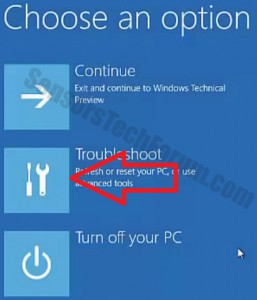
Substep 4:
You will see the Troubleshoot menu. From this menu you can choose Advanced Options.

Substep 5:
After the Advanced Options menu appears, click on Startup Settings.
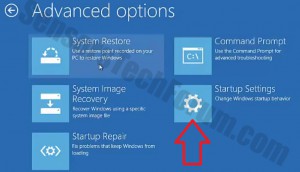
Substep 6:
Substep 7:
A menu will appear upon reboot. You should choose Safe Mode by pressing its corresponding number and the machine will restart and boot into Safe Mode so you can scan for and remove TrojanDownloader:Win32/Bagoox.A.
Step 2: Remove TrojanDownloader:Win32/Bagoox.A automatically by downloading an advanced anti-malware program.
To clean your computer you should download an updated anti-malware program on a safe PC and then install it on the affected computer in offline mode. After that you should boot into safe mode and scan your computer to remove all TrojanDownloader:Win32/Bagoox.A associated objects.
Preparation before removing TrojanDownloader:Win32/Bagoox.A.
Before starting the actual removal process, we recommend that you do the following preparation steps.
- Make sure you have these instructions always open and in front of your eyes.
- Do a backup of all of your files, even if they could be damaged. You should back up your data with a cloud backup solution and insure your files against any type of loss, even from the most severe threats.
- Be patient as this could take a while.
- Scan for Malware
- Fix Registries
- Remove Virus Files
Step 1: Scan for TrojanDownloader:Win32/Bagoox.A with SpyHunter Anti-Malware Tool



Step 2: Clean any registries, created by TrojanDownloader:Win32/Bagoox.A on your computer.
The usually targeted registries of Windows machines are the following:
- HKEY_LOCAL_MACHINE\Software\Microsoft\Windows\CurrentVersion\Run
- HKEY_CURRENT_USER\Software\Microsoft\Windows\CurrentVersion\Run
- HKEY_LOCAL_MACHINE\Software\Microsoft\Windows\CurrentVersion\RunOnce
- HKEY_CURRENT_USER\Software\Microsoft\Windows\CurrentVersion\RunOnce
You can access them by opening the Windows registry editor and deleting any values, created by TrojanDownloader:Win32/Bagoox.A there. This can happen by following the steps underneath:


 Tip: To find a virus-created value, you can right-click on it and click "Modify" to see which file it is set to run. If this is the virus file location, remove the value.
Tip: To find a virus-created value, you can right-click on it and click "Modify" to see which file it is set to run. If this is the virus file location, remove the value.Step 3: Find virus files created by TrojanDownloader:Win32/Bagoox.A on your PC.
1.For Windows 8, 8.1 and 10.
For Newer Windows Operating Systems
1: On your keyboard press + R and write explorer.exe in the Run text box and then click on the Ok button.

2: Click on your PC from the quick access bar. This is usually an icon with a monitor and its name is either “My Computer”, “My PC” or “This PC” or whatever you have named it.

3: Navigate to the search box in the top-right of your PC's screen and type “fileextension:” and after which type the file extension. If you are looking for malicious executables, an example may be "fileextension:exe". After doing that, leave a space and type the file name you believe the malware has created. Here is how it may appear if your file has been found:

N.B. We recommend to wait for the green loading bar in the navigation box to fill up in case the PC is looking for the file and hasn't found it yet.
2.For Windows XP, Vista, and 7.
For Older Windows Operating Systems
In older Windows OS's the conventional approach should be the effective one:
1: Click on the Start Menu icon (usually on your bottom-left) and then choose the Search preference.

2: After the search window appears, choose More Advanced Options from the search assistant box. Another way is by clicking on All Files and Folders.

3: After that type the name of the file you are looking for and click on the Search button. This might take some time after which results will appear. If you have found the malicious file, you may copy or open its location by right-clicking on it.
Now you should be able to discover any file on Windows as long as it is on your hard drive and is not concealed via special software.
TrojanDownloader:Win32/Bagoox.A FAQ
What Does TrojanDownloader:Win32/Bagoox.A Trojan Do?
The TrojanDownloader:Win32/Bagoox.A Trojan is a malicious computer program designed to disrupt, damage, or gain unauthorized access to a computer system.
It can be used to steal sensitive data, gain control over a system, or launch other malicious activities.
Can Trojans Steal Passwords?
Yes, Trojans, like TrojanDownloader:Win32/Bagoox.A, can steal passwords. These malicious programs are designed to gain access to a user's computer, spy on victims and steal sensitive information such as banking details and passwords.
Can TrojanDownloader:Win32/Bagoox.A Trojan Hide Itself?
Yes, it can. A Trojan can use various techniques to mask itself, including rootkits, encryption, and obfuscation, to hide from security scanners and evade detection.
Can a Trojan be Removed by Factory Reset?
Yes, a Trojan can be removed by factory resetting your device. This is because it will restore the device to its original state, eliminating any malicious software that may have been installed. Bear in mind, that there are more sophisticated Trojans, that leave backdoors and reinfect even after factory reset.
Can TrojanDownloader:Win32/Bagoox.A Trojan Infect WiFi?
Yes, it is possible for a Trojan to infect WiFi networks. When a user connects to the infected network, the Trojan can spread to other connected devices and can access sensitive information on the network.
Can Trojans Be Deleted?
Yes, Trojans can be deleted. This is typically done by running a powerful anti-virus or anti-malware program that is designed to detect and remove malicious files. In some cases, manual deletion of the Trojan may also be necessary.
Can Trojans Steal Files?
Yes, Trojans can steal files if they are installed on a computer. This is done by allowing the malware author or user to gain access to the computer and then steal the files stored on it.
Which Anti-Malware Can Remove Trojans?
Anti-malware programs such as SpyHunter are capable of scanning for and removing Trojans from your computer. It is important to keep your anti-malware up to date and regularly scan your system for any malicious software.
Can Trojans Infect USB?
Yes, Trojans can infect USB devices. USB Trojans typically spread through malicious files downloaded from the internet or shared via email, allowing the hacker to gain access to a user's confidential data.
About the TrojanDownloader:Win32/Bagoox.A Research
The content we publish on SensorsTechForum.com, this TrojanDownloader:Win32/Bagoox.A how-to removal guide included, is the outcome of extensive research, hard work and our team’s devotion to help you remove the specific trojan problem.
How did we conduct the research on TrojanDownloader:Win32/Bagoox.A?
Please note that our research is based on an independent investigation. We are in contact with independent security researchers, thanks to which we receive daily updates on the latest malware definitions, including the various types of trojans (backdoor, downloader, infostealer, ransom, etc.)
Furthermore, the research behind the TrojanDownloader:Win32/Bagoox.A threat is backed with VirusTotal.
To better understand the threat posed by trojans, please refer to the following articles which provide knowledgeable details.













